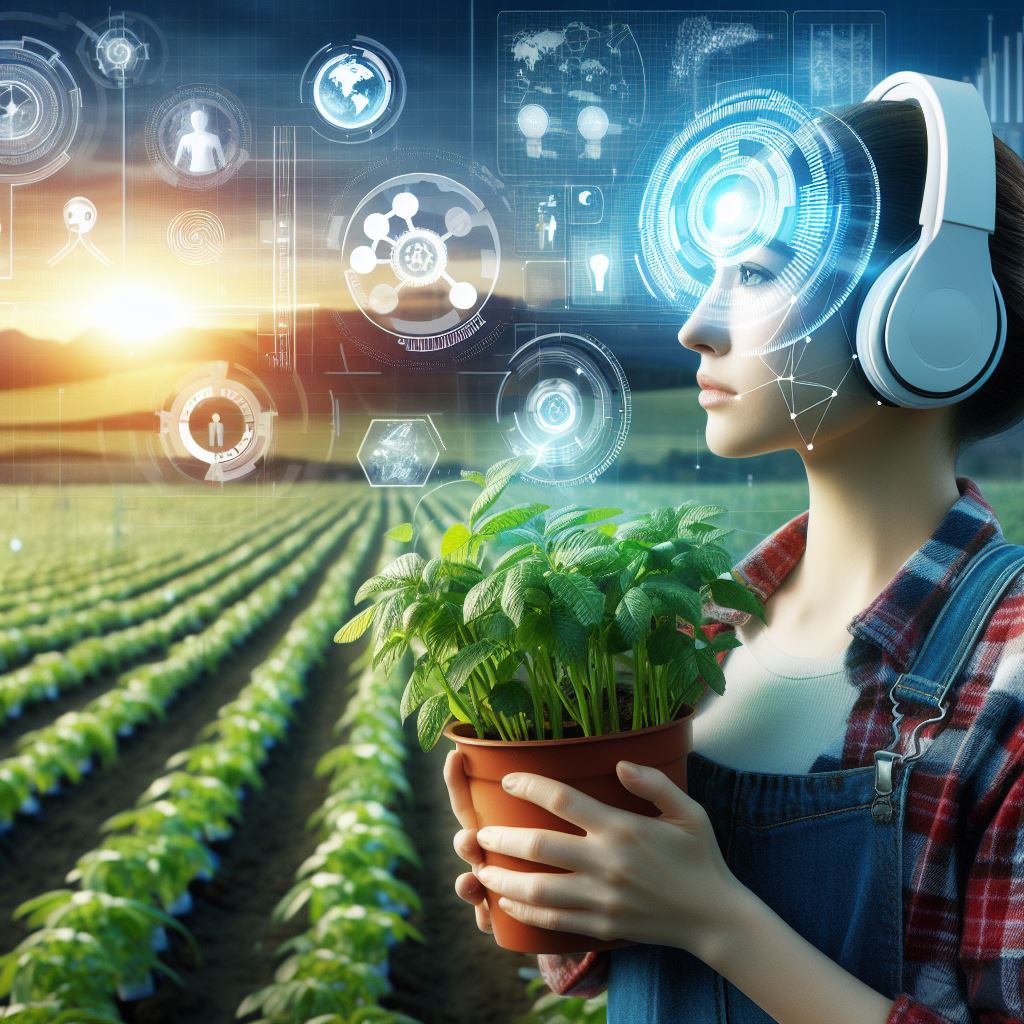Introduction
High-tech farming refers to the integration of advanced technological practices in agriculture to enhance productivity and efficiency.
This approach is crucial on small land due to limited space availability.
The significance of high-tech farming on small land stems from its ability to maximize yield with minimal resources.
With the use of precision technology, farmers can optimize water and fertilizer usage, reducing waste and saving costs.
Furthermore, high-tech farming allows for greater control over environmental factors, such as temperature and humidity.
This control ensures optimal growing conditions, resulting in higher crop quality and greater profitability for small land farmers.
In addition, the automation of various farming processes through advanced technology streamlines operations, saving time and labor.
This is particularly advantageous for small land farmers who may have limited human resources.
Moreover, high-tech farming enables farmers to monitor their crops more effectively.
Through the use of sensors and data analytics, farmers can collect real-time information on plant health and make informed decisions for pest control and disease management.
The adoption of high-tech farming practices also facilitates the integration of vertical farming systems, which entails growing crops in vertically stacked layers.
This technique allows for higher production in compact spaces, making it well-suited for small land farming.
In fact, high-tech farming plays a vital role in maximizing productivity and sustainability on small land.
By leveraging advanced technologies, farmers can overcome space limitations and optimize resource usage, leading to increased profitability and a more sustainable agricultural industry.
Advantages of high-tech farming on small land
High-tech farming has revolutionized the agriculture industry by incorporating advanced technologies to maximize productivity and efficiency on limited land.
Let’s explore the advantages of high-tech farming on small land.
Increased productivity and efficiency
Increased productivity and efficiency are two major benefits of high-tech farming.
With the use of technology such as drones, sensors, and artificial intelligence, farmers can precisely monitor their crops, identify any issues, and take corrective measures promptly.
This helps optimize crop growth and facilitates higher yields on small parcels of land.
Optimum use of resources
Furthermore, high-tech farming enables the optimum use of resources.
By collecting data on soil quality, moisture levels, and nutrient requirements, farmers can make informed decisions regarding irrigation, fertilization, and pest control.
This targeted approach minimizes resource wastage, reduces environmental impact, and ensures efficient utilization of available resources.
Reduction in labor costs
One significant advantage of high-tech farming on small land is the reduction in labor costs.
Automation and robotics have made several farming tasks more efficient and less labor-intensive.
Machines can perform tasks such as planting, harvesting, and even monitoring crop health.
This eliminates the need for a large workforce, reducing labor expenses for farmers.
Greater control over environmental factors
In addition, high-tech farming provides greater control over environmental factors.
By using climate control systems, farmers can adjust temperature, humidity, and light levels within their greenhouses.
This precision control ensures optimal conditions for crop growth year-round, independent of external weather conditions.
Farmers can grow crops that are not native to their region, increase overall harvests, and extend the growing season.
Beyond the advantages listed, high-tech farming also offers benefits such as reduced pesticide usage and improved data-driven decision-making.
Through advanced monitoring systems, farmers can detect pests and diseases early, allowing for targeted pesticide application.
This reduces the overall use of chemical inputs and minimizes their impact on the environment.
Additionally, high-tech farming provides farmers with valuable data and insights.
By analyzing data collected through sensors and satellite imagery, farmers can make informed decisions regarding crop selection, planting times, and resource allocation.
This data-driven approach leads to more efficient farming practices and improved outcomes.
In short, high-tech farming on small land offers numerous advantages for farmers.
Increased productivity and efficiency, optimum resource utilization, reduced labor costs, and greater control over environmental factors are just a few of the benefits.
As technology continues to advance, high-tech farming will play a crucial role in ensuring food security and sustainability in the face of growing global challenges.
Transform Your Agribusiness
Unlock your farm's potential with expert advice tailored to your needs. Get actionable steps that drive real results.
Get StartedTypes of high-tech farming techniques suitable for small land
Vertical farming, hydroponics, aquaponics, and precision agriculture all offer unique advantages for small land areas.
Each technique has its own unique features that contribute to their suitability for small-scale farming.
Vertical farming
Vertical farming allows farmers to maximize vertical space, making it an ideal choice for urban areas.
By utilizing vertical stacking, farmers can produce a high volume of crops within a relatively small area.
The controlled environment also enables year-round cultivation, ensuring a steady supply of fresh produce.
Hydroponics
Hydroponics, on the other hand, eliminates the need for soil, reducing the land area required for cultivation.
This technique also saves water as it recirculates and reuses nutrient-rich water solutions.
With hydroponics, plants can grow faster and produce higher yields compared to traditional soil-based methods.
Aquaponics
Aquaponics takes the benefits of hydroponics one step further by integrating fish farming into the system.
The fish waste provides nutrients for the plants, while the plants filter and purify the water for the fish.
This symbiotic relationship leads to efficient resource utilization and increased productivity.
Precision agriculture
Precision agriculture harnesses the power of modern technology to optimize farming practices.
By using GPS, sensors, and drones, farmers can monitor crop growth, detect nutrient deficiencies, and apply treatments precisely where needed.
This targeted approach minimizes waste and maximizes crop health and productivity.
These high-tech farming techniques offer promising solutions for small land areas, providing opportunities for sustainable and efficient agriculture.
By adopting these practices, farmers can increase their yields, utilize resources effectively, and contribute to a more sustainable food system.
Embracing technology in agriculture is essential to meet the challenges of a growing population and limited resources.
As we move towards a more technology-driven future, high-tech farming techniques will play a crucial role in ensuring food security and sustainable agriculture on small land areas.
These innovations will continue to evolve, enabling farmers to adapt and thrive in a changing world.
Benefits of vertical farming on small land
Vertical farming, a high-tech method of farming, offers numerous benefits for small landowners.
This innovative technique maximizes space utilization, allowing for efficient cultivation and increased production.
By utilizing vertical structures, farmers can significantly enhance their yield and generate substantial profits.
Allows year-round production
One major advantage of vertical farming is its ability to enable year-round production.
Traditional farming methods are heavily influenced by weather conditions, resulting in seasonal limitations.
However, with vertical farming, crops can be grown throughout the year, irrespective of external weather factors.
This allows farmers to have a consistent and reliable source of income, regardless of the season or climate.
Decreases dependency on weather conditions
Furthermore, vertical farming reduces dependency on weather conditions.
Unpredictable changes in weather can significantly impact traditional farming, leading to crop failures and economic losses.
In contrast, vertical farming provides a controlled environment for crops, allowing farmers to regulate factors such as temperature, humidity, and light intensity.
This level of control ensures optimal growing conditions and minimizes the risk of crop damage due to adverse weather.
In addition to weather independence, vertical farming also boasts the advantage of decreased water usage.
Traditional farming methods require large amounts of water for irrigation, leading to excessive consumption and wastage.
Vertical farming, on the other hand, employs advanced irrigation techniques that optimize water usage.
With precise watering systems, crops receive just the right amount of water they need, minimizing waste and maximizing efficiency.
Moreover, vertical farming promotes sustainability by minimizing the need for pesticides and herbicides.
This method provides a controlled environment that reduces the risk of pest infestations and plant diseases.
Consequently, farmers can rely less on harmful chemical substances, thus minimizing the negative environmental impacts associated with traditional farming practices.
Another major benefit of vertical farming is the ability to produce more food per square meter of land.
By utilizing vertical space, farmers can cultivate multiple layers of crops, effectively maximizing their land use.
This efficient space utilization allows small landowners to compete with larger farms in terms of production capacity.
It enables them to grow a wide range of crops in a limited space, leading to increased profitability and economic viability.
Additionally, vertical farming facilitates the implementation of advanced automation and technology.
From automated irrigation systems to robotic harvesting, vertical farms can integrate state-of-the-art technology to streamline the farming process.
This not only improves efficiency but also reduces labor costs, making it an economically viable option for small landowners.
Reduces water usage
Furthermore, vertical farming contributes to the local food supply chain.
With urbanization on the rise, the distance between farms and consumers has increased.
Vertical farms can be established in urban areas, bringing the production closer to the consumers.
This reduces transportation costs and ensures that fresh produce is readily available, promoting healthier eating habits and minimizing the carbon footprint associated with long-distance transportation.
In general, vertical farming offers numerous benefits for small landowners.
Its ability to maximize space utilization, enable year-round production, reduce dependency on weather conditions, and decrease water usage makes it a sustainable and economically viable method of farming.
As technology continues to advance, vertical farming holds great potential for revolutionizing the agricultural industry and ensuring food security for future generations.
Read: Tech Meets Soil: Young Farmers’ Tales
Advantages of Hydroponics
Hydroponics, a soilless cultivation method, revolutionizes farming on small land by offering unparalleled efficiency in water and nutrient usage.
Unlike traditional soil-based farming, hydroponics allows for precise control over the delivery of water and nutrients directly to plant roots.
This precision ensures that plants receive optimal amounts of essential elements, minimizing waste and maximizing growth potential.
As a result, hydroponic systems often produce higher yields per square foot compared to conventional methods.
Another significant advantage of hydroponics is its ability to promote faster plant growth.
By providing plants with all necessary nutrients in a readily available form, hydroponic systems create optimal conditions for accelerated growth rates.
This rapid growth not only shortens the time to harvest but also increases overall productivity, allowing farmers to cultivate more crops within a given growing season.
Moreover, hydroponics minimizes the risk of pests and diseases, a common concern in traditional soil-based farming.
In a soilless system, pests and diseases that typically thrive in soil are greatly reduced, leading to healthier plants and decreased reliance on chemical pesticides.
By eliminating the need for soil, hydroponics creates a clean and controlled growing environment that is less hospitable to harmful organisms, thereby reducing the likelihood of crop damage and losses.
Additionally, hydroponics helps to reduce soil erosion, a significant environmental benefit.
With no soil to till or disturb, there is minimal disruption to the land, preserving valuable topsoil and preventing erosion.
This conservation of soil resources not only maintains soil health but also contributes to long-term sustainability in agriculture.
In summary, hydroponics offers a range of advantages for high-tech farming on small land areas.
From efficient resource usage and faster plant growth to enhanced crop protection and soil conservation, hydroponic systems empower farmers to achieve greater productivity and sustainability in their operations.
Read: Colorado Rancher’s Sustainable Cattle Tale

Benefits of aquaponics on small land
Aquaponics is a farming method that combines aquaculture and hydroponics in a symbiotic system.
This innovative technique is gaining popularity, especially in urban settings, due to its numerous benefits for small landowners.
Let’s explore these benefits in more detail.
Showcase Your Farming Business
Publish your professional farming services profile on our blog for a one-time fee of $200 and reach a dedicated audience of farmers and agribusiness owners.
Publish Your ProfileSimultaneous cultivation of fish and plants
One of the key advantages of aquaponics is the simultaneous cultivation of fish and plants.
In this system, fish are reared in tanks, while plants are grown in water beds or channels that are constantly flooded with nutrient-rich water.
This allows for a diverse range of food production, providing both protein from fish and vegetables from plants.
Natural fertilization through fish waste
Furthermore, aquaponics enables natural fertilization through fish waste.
The waste produced by fish contains essential nutrients that are absorbed by plants, acting as a natural fertilizer.
This eliminates the need for synthetic or chemical fertilizers, minimizing the environmental impact of farming activities.
Additionally, the combination of fish and plants creates a balanced ecosystem where the plants purify the water for the fish, promoting a sustainable and self-sufficient farming system.
Efficient use of water resources
Water scarcity is a growing concern worldwide, making efficient use of water resources crucial.
Aquaponics stands out in this regard, as it utilizes water in a highly efficient manner.
The water in the system is continuously circulated, meaning that evaporation and runoff are minimized.
Additionally, the water is constantly filtered and purified by the plants, reducing the need for excessive water changes.
This not only conserves water but also makes aquaponics a viable option in regions with limited water availability.
Increased biodiversity
Another benefit of aquaponics is the increased biodiversity it promotes.
In conventional farming methods, monocultures are often practiced, risking the loss of genetic diversity and increasing the vulnerability of crops to diseases and pests.
However, in aquaponics, multiple species of fish and plants are cultivated together, creating a more balanced and resilient ecosystem.
This diversity enhances the overall stability and productivity of the system.
Moreover, aquaponics is highly adaptable and suitable for small landowners, including those residing in urban areas.
With the use of vertical growing systems and compact designs, aquaponics can be implemented even in limited spaces.
This opens up opportunities for urban agriculture, allowing individuals to produce their own food within the confines of their homes or communities.
The versatility of aquaponics makes it an attractive option for those seeking sustainable food production solutions in densely populated areas.
In a nutshell, aquaponics offers numerous benefits for small landowners.
Simultaneous cultivation of fish and plants, natural fertilization through fish waste, efficient use of water resources, and increased biodiversity are just a few advantages of this innovative farming method.
By harnessing the power of aquaponics, individuals can create sustainable, self-sufficient, and diverse farming systems, even on small plots of land.
Read: From Conventional to Organic: A Farmer’s Path
Gain More Insights: Climate Smart Farming: Adapting with Tech
Advantages of precision agriculture on small land
Precision agriculture, also known as high-tech farming, offers numerous advantages when implemented on small plots of land.
This advanced farming approach utilizes cutting-edge technologies to optimize agricultural practices and increase productivity.
By utilizing precision agriculture techniques, farmers can take advantage of several key benefits:
Optimized use of fertilizers and pesticides
- Optimized use of fertilizers and pesticides: Precision agriculture allows farmers to minimize the use of fertilizers and pesticides by accurately applying them only where needed. This targeted approach reduces waste, decreases environmental impact, and saves costs.
- Improved crop monitoring and data analysis: With precision agriculture, farmers can use sensors and data collection tools to monitor crops in real-time. This technology provides valuable insights into soil conditions, plant health, and growth patterns. By analyzing this data, farmers can make informed decisions about irrigation, pest control, and harvesting.
- Efficient irrigation systems: Precision agriculture employs advanced irrigation techniques, such as drip irrigation or soil moisture sensors, to optimize water usage. By delivering water directly to the roots of plants based on their specific needs, farmers can minimize water loss and increase water-use efficiency.
- Enhanced decision-making through GPS technology: Precision agriculture integrates GPS technology, allowing farmers to precisely track their location and monitor their field activities. This technology enables farmers to create accurate maps of their land, plan efficient routes for machinery, and systematically analyze data for improved decision-making.
Improved crop monitoring and data analysis
In addition to these advantages, precision agriculture also offers several other significant benefits for small-scale farmers:
- Increased productivity: By precisely managing inputs, monitoring crop health, and utilizing data-driven insights, precision agriculture can significantly increase overall crop productivity. Farmers can maximize yields and cultivate crops more efficiently, leading to higher profits and sustainable growth.
- Resource conservation: Precision agriculture promotes sustainable farming practices by minimizing resource wastage. By using technology to target inputs, farmers can reduce excessive use of fertilizers, pesticides, and water. This not only reduces environmental impact but also leads to significant cost savings.
- Reduced labor requirements: Precision agriculture automation mitigates labor-intensive tasks, enabling small-scale farmers to streamline their operations. Automated machines can perform repetitive tasks such as seeding, fertilizing, and harvesting with precision, reducing the need for manual labor and optimizing workforce allocation.
- Enhanced quality control: By closely monitoring crops and environmental conditions, precision agriculture allows farmers to ensure consistent and high-quality produce. This technology enables detection of potential issues at an early stage, enabling prompt corrective action to maintain product quality and consumer satisfaction.
- Improved sustainability: Precision agriculture plays a crucial role in promoting sustainable agricultural practices. By reducing chemical usage, conserving resources, and minimizing environmental impact, farmers can contribute to the long-term preservation of natural resources for future generations.
In summary, the adoption of precision agriculture techniques offers significant advantages for small-scale farmers.
The optimized use of fertilizers and pesticides, improved crop monitoring, efficient irrigation systems, and enhanced decision-making through GPS technology provide valuable tools for maximizing productivity, conserving resources, and promoting sustainability.
By embracing precision agriculture, small land farmers can leverage the power of technology to ensure long-term success and contribute to the growth of the agricultural industry.
Read: Innovative Farming: The Youth’s Approach
Challenges and considerations of high-tech farming on small land
The concept of high-tech farming on small land presents numerous challenges and considerations that must be carefully analyzed and addressed.
While this innovative approach to agriculture offers numerous benefits, such as increased productivity and sustainability, it is essential to understand and overcome the hurdles that come with it.
In this blog section, we will delve into the challenges and considerations of high-tech farming on small land and discuss potential solutions.
Initial investment costs
One of the primary challenges of high-tech farming on small land is the initial investment costs.
Implementing advanced technologies, such as precision agriculture systems and automated machinery, requires a significant financial commitment.
The cost of acquiring and installing these technologies can be prohibitive for small-scale farmers with limited capital.
To overcome this obstacle, farmers can explore various funding options, such as grants or loans, specifically tailored for agricultural innovations.
Technological expertise and training
Another crucial consideration for high-tech farming on small land is the need for technological expertise and training.
Many of the advanced systems and equipment used in this approach require specialized knowledge to operate efficiently.
Small-scale farmers may lack the necessary expertise and training to leverage these technologies effectively.
Collaborating with agricultural experts or participating in training programs can bridge this knowledge gap and ensure that farmers optimize their use of high-tech farming methods.
Energy consumption
Energy consumption is yet another challenge associated with high-tech farming on small land.
Advanced technologies, such as climate control systems and lighting, demand a considerable amount of energy.
This increased energy requirement can result in higher operational costs and have an environmental impact.
To address this issue, farmers can explore renewable energy options, such as solar panels or wind turbines, to power their high-tech farming operations and reduce dependency on traditional energy sources.
Maintenance and troubleshooting
Maintenance and troubleshooting also pose significant challenges for high-tech farming on small land.
As advanced technologies become more complex, the need for regular maintenance and quick resolution of technical issues arises.
Small-scale farmers may lack the resources or expertise to handle such maintenance and troubleshooting tasks independently.
Collaborating with technology providers or hiring specialized technicians can ensure timely repairs and minimize downtime, thus maximizing overall productivity.
In addition to these challenges, there are several considerations specific to high-tech farming on small land that farmers must address.
Optimizing space utilization within the limited area available is paramount.
Farmers must strategize and implement efficient layouts, considering factors such as crop selection, crop rotation, and vertical farming techniques to maximize yield.
Additionally, implementing effective pest and disease management practices becomes crucial in such a controlled environment to mitigate risks and ensure crop health.
Furthermore, data management and analysis play a vital role in high-tech farming on small land.
With the abundant data generated by various sensors and monitoring systems, farmers must possess the ability to collect, analyze, and interpret this information.
This data-driven approach enables farmers to make informed decisions regarding resource allocation, crop management, and overall optimization.
Implementing suitable farm management software or partnering with data analytics companies can greatly assist in this aspect.
In closing, while high-tech farming on small land offers immense potential for increased productivity and sustainability, it comes with its own set of challenges and considerations.
From initial investment costs to energy consumption and from maintenance to data management, all aspects require careful planning and strategic solutions.
By addressing these challenges and considering the specific requirements of farming on small land, farmers can successfully harness the potential of high-tech agriculture and contribute to a more efficient and sustainable future.
Conclusion
High-tech farming on small land offers numerous benefits and advantages.
The use of technological advancements such as automation and data analytics has revolutionized the agricultural industry.
Farmers who adopt high-tech farming techniques can experience increased productivity, cost-efficiency, and sustainability.
This blog section aimed to shed light on the importance of adopting high-tech farming methods.
Through the use of precision agriculture and vertical farming systems, farmers can optimize land use, reduce water consumption, and minimize the need for chemical inputs.
These techniques enable higher crop yields in a smaller area, making it particularly suitable for small landowners.
Furthermore, high-tech farming offers opportunities for farmers to diversify their income streams.
Through value-added products such as organic produce or hydroponically grown vegetables, farmers can tap into niche markets and command higher prices.
Additionally, digital platforms allow direct-to-consumer sales, eliminating the need for intermediaries and increasing profit margins.
To ensure the continued growth and success of high-tech farming, ongoing research and innovation are imperative.
Agricultural technology companies and research institutions must collaborate to develop new solutions and refine existing techniques.
This will enable farmers to stay at the forefront of technological advancements, maximize their productivity, and minimize environmental impact.
Basically, high-tech farming on small land holds immense potential for farmers.
Embracing these techniques not only brings financial benefits but also contributes to sustainable and resource-efficient agriculture.
By harnessing the power of technology, farmers can pave the way for a more secure and resilient food system for future generations.




